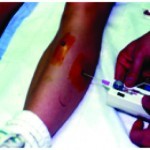Detecting compartment syndrome
Nurses are expected to know the symptoms of compartment syndrome and identify patients at risk for its development. The assessment of pulses, sensation, and movement of a limb will detect early signs of compartment syndrome. This is a dreaded complication that can cause massive damage to a limb.
Compartment syndrome can develop in an arm, leg, abdomen, hand or foot. It can result from a crush injury, tight casts, burns, bleeding, trauma, fractures, or swelling from a soft tissue injury. It can even result from prolonged surgery that puts pressure on the body. The syndrome develops because the fascia that surrounds the compartment does not stretch when swelling occurs. The swelling causes increased pressure on the structures in the area and thus blocks blood flow.
Compartment syndrome is a serious and painful condition that involves increased pressure in a muscle compartment. The pressure escalates to dangerous levels and compresses muscles, nerves and blood vessels. This can cause tissue death is not detected or acted upon in time. Acute compartment syndrome is a medical emergency that develops over hours.
Annemarie Costello, an experienced orthopaedic clinical specialist from Thomas Jefferson University Medical Center. She explored the clinical and liability aspects of this condition.


